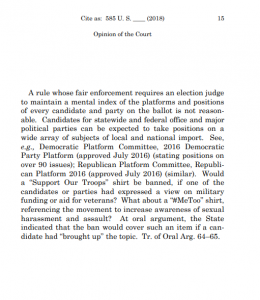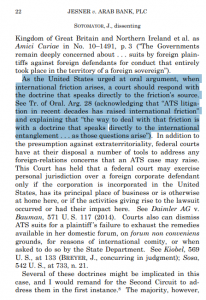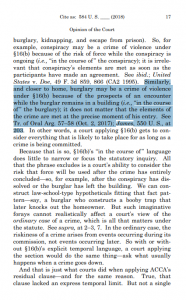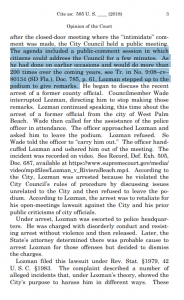Empirical SCOTUS: Don’t cite me like that


An interesting debate was reignited by Chief Justice John Roberts’ majority opinion in Minnesota Voter’s Alliance v. Mansky. This debate surrounds the effect, if any, of oral argument on the justices’ decisions. Here is one of the sections from Roberts’ majority opinion in that case that refers to the oral argument.
 In this example, as with many of the instances in which justices cite oral-argument transcripts, the authoring justice used the interaction to expose a weakness in a party’s argument. Roberts refers to the portion of the proceedings when several of the justices, most notably Justice Samuel Alito, engaged the respondents’ attorney Daniel Rogan about the extent of the apparel ban under the statute.
In this example, as with many of the instances in which justices cite oral-argument transcripts, the authoring justice used the interaction to expose a weakness in a party’s argument. Roberts refers to the portion of the proceedings when several of the justices, most notably Justice Samuel Alito, engaged the respondents’ attorney Daniel Rogan about the extent of the apparel ban under the statute.
Looking back at the oral-argument transcript, Alito seemingly caught the attorney in a trap in which an affirmative response, although appropriate, could lead the court to conclude that the state statute was too broad to pass constitutional muster. This raises the question of whether the oral argument led to the petitioners’ victory in the case (I looked at a related question in separate post.). Without information on the justices’ deliberations, such as a justice’s personal papers, it is nearly impossible to answer this question with any degree of certainty. Still, both the specifics of this case and Supreme Court cases generally say a lot about the importance of oral argument.
Although not conclusive, the justices’ decisions about when and how much to speak at oral argument are often indicative of their voting positions. In Mansky, the order and amount of speaking looked like this during the petitioners’ turn:

And like this during the respondents’ turn:

By breaking these figures down to their composite numbers, it becomes clear that Alito, Roberts and Justices Neil Gorsuch and Stephen Breyer spoke more during the respondents’ turn. Speaking more to one side is often correlated with voting against that side, and although Justice Clarence Thomas did not speak at oral argument, he generally agrees with coalitions that include Roberts, Alito and Gorsuch. This leads to the question of whether the oral argument in Mansky helped move Justices Ruth Bader Ginsburg, Anthony Kennedy and Elena Kagan to the majority. I will return to this question toward the end of the post.
The justices cited oral-argument transcripts in 69 distinct instances in opinions this term (Multiple citations in one place were treated as one instance.). The case breakdown of where these cites appeared is as follows:

Roberts’ opinion in Mansky, the case with the most cites to the oral argument, mainly used the transcript to oppose the position of the party/attorney involved in the cited segment of the argument. When grouped together into themes, other reasons for citations to oral-argument transcripts this term aside from opposing a particular position include describing when a party conceded a position, explaining the government’s stance on an issue, explaining the relevant law, detailing a party’s position and explaining or illustrating the justice’s point.
Each of these types is easily identifiable. Here is an example of a citation to a concession from Alito’s dissent in Collins v. Virginia:
In this instance, Alito merely cited the oral-argument transcript to show that neither party disputed his assertion. Although the justices may use these kinds of points to support their views in a case, such citations have the initial appearance of neutrality.
Arguments were also cited to explain the government’s positions, as in Justice Sonia Sotomayor’s opinion in Jesner v. Arab Bank, PLC:
The federal government’s position on issues is generally shown deference even if is not adopted by the Supreme Court. The regard the justices tend to pay to statements from the federal government’s attorneys shows that their arguments are at least cursorily examined, as they were here.
Oral arguments may also be used as a tool to explain the law. The following is an example from Justice Elena Kagan’s majority opinion in Sessions v. Dimaya:
The oral-argument transcript in this instance is used as a tool of statutory interpretation. In such a situation, oral arguments may have a neutral application or they may be used to show why a particular view of a law’s meaning is superior to another.
Oral arguments may also be used to lay out specific facts. When this is the purpose of the citation, the justices may look for facts that are particularly favorable to their positions. Below is an example from Kennedy’s majority opinion in Lozman v. Riviera Beach.
The scenario as Kennedy described it included specific details, like the number of times Fane Lozman attended the city-council sessions. In this way, Kennedy set the stage for various interpretations of what Lozman’s regular attendance implies or, conversely, of the importance of the arrest on that particular occasion.
One final way that the justices cited oral arguments in opinions this term was to highlight a party’s positions that may or may not be adopted by the Supreme Court. The following example is from Kagan’s majority opinion in Sveen v. Melin.
The party’s position may be articulated to create a straw-man argument that the authoring justice later deconstructs. This is the trajectory followed by Kagan in the above instance. By citing a party’s own views on an issue, justices have the opportunity to engage in a secondary dialogue, not directly with the party’s attorney, but rather with the transcripts that expose the attorney’s positions.
These six types of oral-argument citations are employed purposefully. With the benefit of a party’s assessments, the justices interpret particular arguments, often in order to explain why they are invalid or incorrect.
The justices’ individual uses of the types of citations so far this term is shown next.

The most frequent purpose of oral-argument citations so far this term has been to convey a party’s position. Within this area Roberts is the most frequent citing justice, followed by Kagan and Sotomayor. The rationale for this type of citation is often to develop an argument against the party’s position.
Justices may oppose a party’s position more directly, as Roberts did in Mansky by citing examples from oral argument of miscalculated or erroneous answers. Rather than merely restating a party’s position, these citations often come up in hypothetical applications that the justices use to test the soundness of a particular argument. Kagan and Thomas are the two justices who followed this approach the most in their opinions. (Thomas did not ask any questions during oral arguments this term.)
Oral arguments most likely affect the justices on the margins. We may never know about all the instances when justices’ votes were swayed by the proceedings, but we can make educated guesses, as I did in Mansky, by comparing the justices’ likely and actual votes (The likely votes may be at different points in time, such as before and after oral argument.). Comparisons like these over time may shed additional light on both the justices’ uses for oral arguments and the effect these arguments have on case outcomes.
On an unrelated note: The justices have punted in multiple high-profile cases that were argued this term. These include Benisek v. Lamone and Gill v. Whitford, but also much of Masterpiece Cakeshop v. Colorado Civil Rights Commission. The Supreme Court has not been shy about remanding gerrymandering cases in the past without much substantive guidance. It even did so last term with North Carolina v. Covington. What if Roberts, the master tactician on the court, has learned the importance of cooperation from the eight-justice Scalia-less court of 2015 and 2016? For all of the court’s politically charged decisions under Roberts, the chief justice now seems to shy away from 5-4 ideologically divided decisions in politicized cases. Without a ninth justice, the court managed to avoid big decisions in highly charged cases such as Friedrichs v. California Teachers Association, Zubik v. Burwell and United States v. Texas. If Roberts prefers this outcome to ideological polarization, maybe he and to a lesser extent the other justices are choosing such compromises over highly fractured decisions. In any case, just a thought.
This post was originally published at Empirical SCOTUS.
Posted in Empirical SCOTUS





